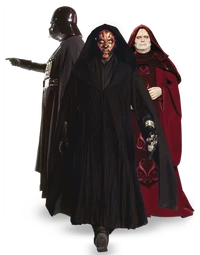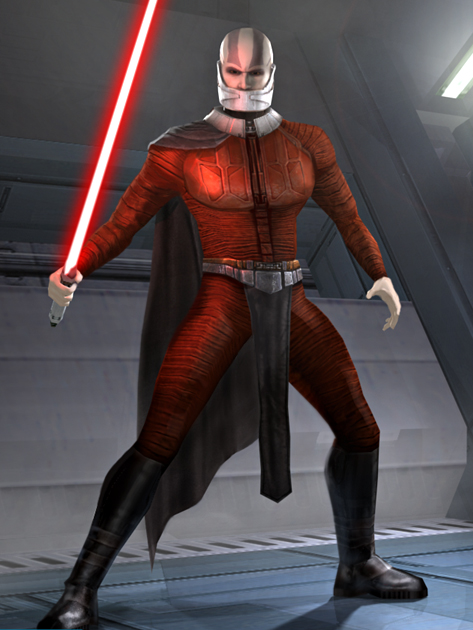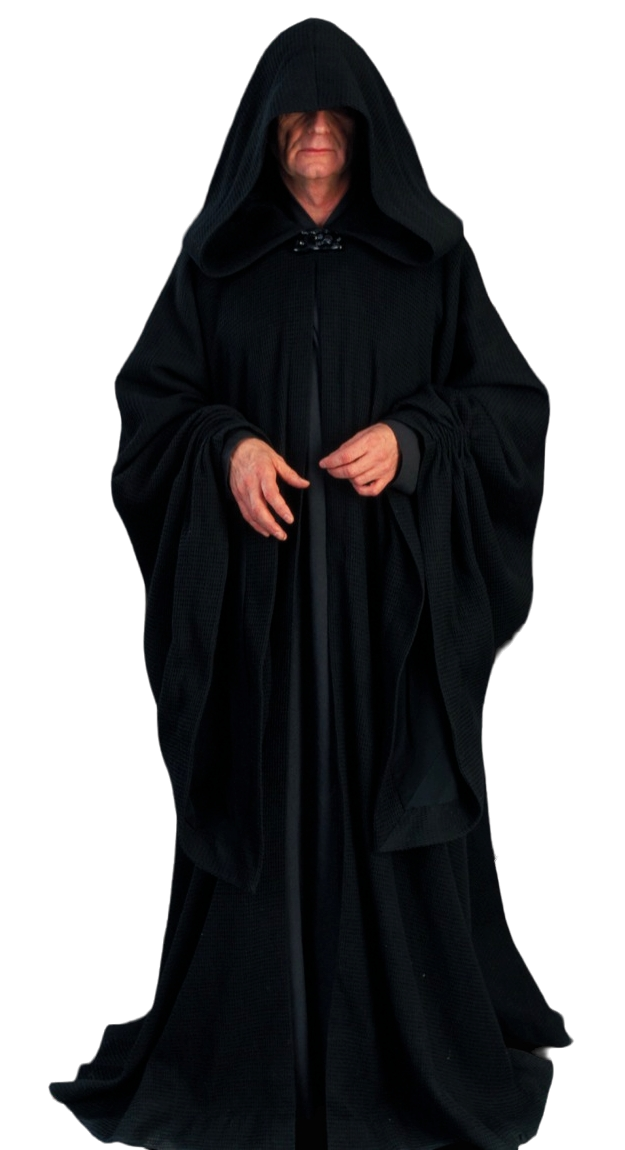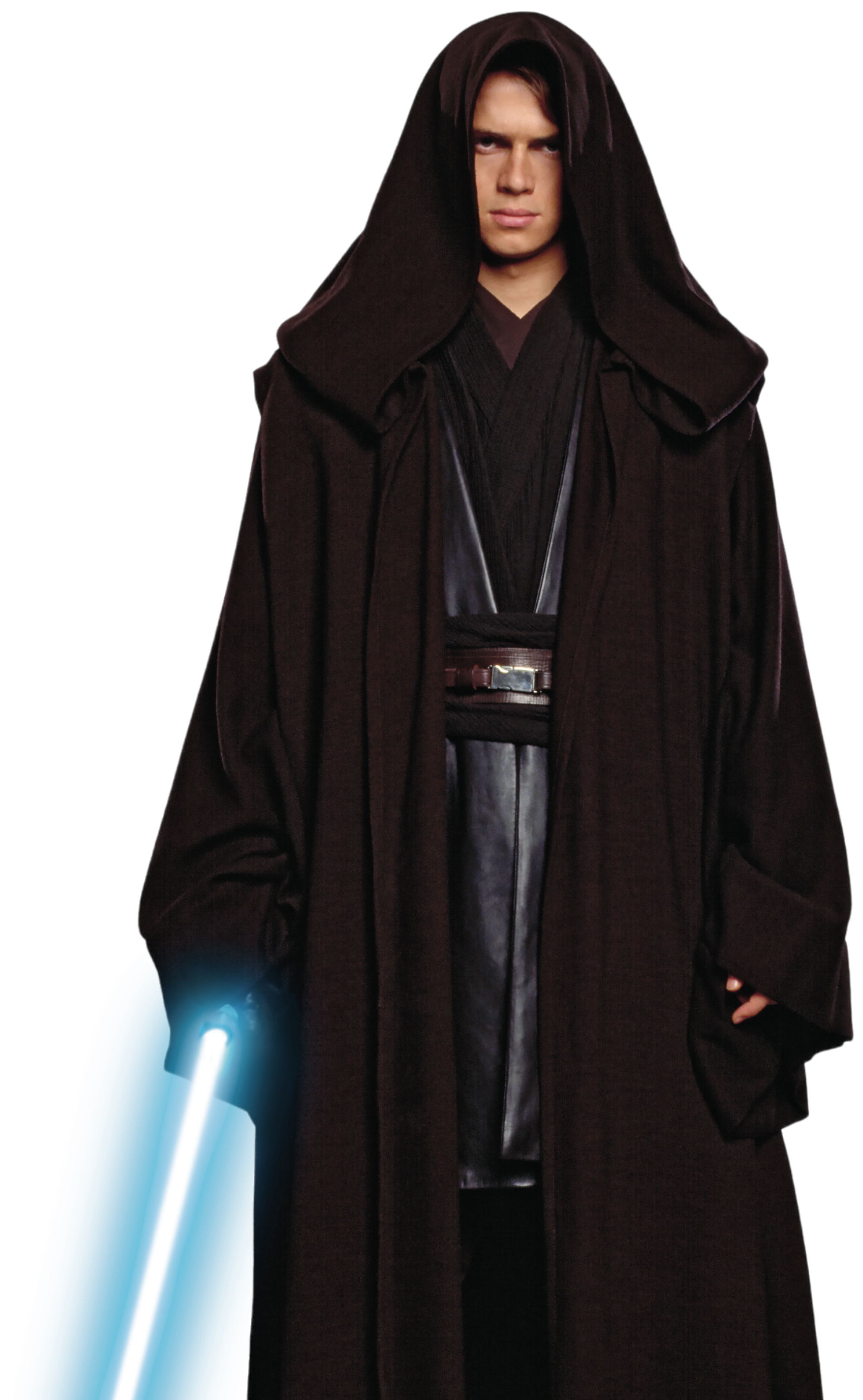 Darth Vader, Darth Maul, and Darth Sidious, all Dark Lords
Darth Vader, Darth Maul, and Darth Sidious, all Dark Lords
Clothing broadly defined the attire typically donned by those belonging to the various iterations of the Sith Order. Most Sith typically wore Sith robes. In contrast to the Jedi, who rejected materialism, the role of a Sith Lord was highly personalized, a trait reflected in the unique personal attire of each Dark Lord.
While bearing some resemblance to the clothing and armor favored by the Jedi Knights of the Galactic Republic, Sith apparel was significantly more tailored to the individual wearer than the attire of their Jedi counterparts. For many Sith, their robes and armor were fundamental to their identity. Those who embraced the dark side often incorporated elements of physical protection into their garments, such as traditional armor plating, cortosis, or even integrated life support systems. Their distinctive clothing often served as a means of recognition, used to intimidate both enemies and allies.

The initial Sith Lords comprised fallen Jedi who subjugated the Sith, a species originating from the Stygian Caldera. This intermingling led to a population and culture that blended traits from both groups. The Sith Order's apparel drew inspiration from the Jedi, the upholders of justice and freedom within the Galactic Republic, and the Sith themselves.
Unlike their Jedi predecessors, the Sith Lords openly displayed their wealth and status. Their fashion choices were extravagant, featuring vibrant colors such as green, light red, and purple, alongside ornamented golden armor components. They also favored elaborate headdresses, war helmets, and capes with unique necklines. Figures like Naga Sadow and Ludo Kressh exemplified this trend. The Sith Lords derived pleasure and a sense of power from the envy and avarice their possessions evoked in others. This mindset persisted for millennia, as evidenced by Master Qordis, known for his luxurious silks, expensive jewelry, and opulent apartments on Korriban.
Robes worn by Sith were specifically known as Sith robes. Many of these robes were imbued with the Force during their creation, designed to enhance the wearer's ability to channel the dark side of the Force and amplify their strength or wisdom. Some of these artifacts remained intact and functional during the Old Sith Wars, including Aleema Keto's and Crado's robes, as well as the infamous Helm of Dathka Graush. Around 5000 BBY, some of the Massassi warriors accompanying Naga Sadow on Yavin 4 were known to wear specialized combat gear that maximized their agility in dense jungle environments.

The Sith Lords of the Old Empire donned personalized battle armor intended to instill fear in their adversaries. While each Sith Lord typically possessed a unique set of armor, standard models were also known to exist. These armors generally consisted of metal plates worn over dark robes, often adorned with sharp spines for offensive purposes. Before 3998 BBY, the young Onderonian metallurgist Shas Dovos crafted his own suit of Sith armor from steel plates, following instructions found in an ancient text. Dovos eventually merged with his armor, transforming into the powerful being known as Warb Null.
Millennia later, Darth Vader's heavy suit continued this tradition of intimidating and fearsome protective coverings. If Vader's armor closely followed the construction methods of ancient armors, it is plausible that Sith Alchemy was used to enhance the wearer's physical strength and vitality.
Following the establishment of the Brotherhood of the Sith by Dark Lords Exar Kun and Ulic Qel-Droma, their initial command to their new students was the Sith uprising, ordering them to eliminate their Jedi masters. Consequently, few apprentices had the opportunity to alter their Jedi attire, resulting in a less standardized Sith Order.
Kun continued the tradition of battle armor, wearing his own. Sith warriors wore robes with hoods to conceal their faces and prevent identification. Some Sith robes also included basic armor made of cortosis. These robes shared stylistic similarities with the Jedi Adventure Robe and the Ceremonial Jedi Robes.

During Revan's founding of his new empire, the Sith likely opted for more practical robes. Technological advancements in previous decades led to a more austere and high-tech aesthetic throughout the galaxy. This likely explains why figures such as Darth Bandon, Darth Malak, and Revan himself wore relatively simple clothing. Darth Revan possessed a special set of armored robes, including a full helmet of Mandalorian design. Many renegade Dark Jedi who joined Revan simply adapted Jedi garment styles to the dark colors of their new allegiance. The Sith Empire also commanded vast numbers of minions, including Sith assault troopers and Sith Assassins, whose outfits were highly specialized.
In the wake of the Mandalorian War, Republic officers who served under Revan defected and joined the new Sith Empire. They replaced their red and yellow uniforms with azure blue/gray jumpsuits, with higher-ranking officers wearing caps. This uniform was also adopted by trainees at the Sith Academy.
Following the Great War, Sith robes were a common choice for Sith serving the Sith Empire and the Sith Emperor during the Cold War between the Sith and the Republic. These robes were heavier than those typically worn before and after the Great War and the Cold War. The Jedi developed a similar garment for their military forces. They also used specialized gauntlets called Warrior's gloves during the Cold War.
During the New Sith Wars, Sith apparel evolved into a more austere style, though retaining hints of the elaborate fashion of ancient Sith Lords. Brighter colors were abandoned in favor of shades of black, dark purple, and gray. Sith typically wore black capes with cuirasses and multi-pouched belts featuring buckles adorned with symbols resembling Sith tattoos. Figures like Lord Skere Kaan and Darth Bane were frequently seen in this attire, with Bane also wearing an armored pauldron and vambrace to protect his left arm. Later, Darth Bane wore biological armor made from hard-shelled orbalisks, which symbiotically enhanced his Force abilities.

The Sith Lords following the establishment of the Rule of Two operated in secrecy and generally favored simpler black garments. Their concealing black robes gave them an appearance akin to creatures of the night.
Darth Sidious preferred monk-like robes made of rough zeyd-cloth. His favored robe was black, featuring a raised waffle pattern and long sleeves extending just below the wrists. By 4 ABY, this gave the impression that Palpatine, Sidious's alter ego, was merely a simple man. In addition to his black robe, Palpatine owned several sets of Sith robes. One set resembled his favored black robes but was made of burgundy material. Another, made of burgundy velvet-like fabric, was ornamented with Sith symbols. Palpatine publicly wore this before the Senate when delivering his Declaration of a New Order, confident that no one in the rotunda would recognize its origin, signaling the end of the Sith's period of hiding. He also had a gray robe with a large hood, a black velvet capelet, and puffed sleeves, as seen during his battle with Yoda. When the reborn Sidious traveled to Korriban in 11 ABY, he wore a shorter, more practical version of his familiar black cape, complete with a capelet and a long, straight walking stick.
Sith apprentices wore specific training gear during their training to become Sith Lords. Darth Maul wore such gear, consisting of a uniquely tailored vest. Upon achieving the rank of Sith Lord, he donned the black garb of the Sith Order. In a more elaborate style than standard zeyd-cloth cloaks, Darth Maul wore black robes and loose-fitting desert-like clothing, including a collared coat belted at the waist. The oversized hood draped down the back, and the elongated sleeves nearly touched the ground, with slits at the arm attachments for Maul to extend his arms.

Darth Tyranus, Sidious's second apprentice, maintained the traditional attire of the Counts of Serenno. This included a dark brown double-breasted Vjun tunic, horse-riding pants, and an armorweave cape designed to broaden his silhouette. He also wore black boots crafted from rare rancor leather, reaching just below the knees.
Although Asajj Ventress was not strictly a Sith, she wore "the trappings of the Sith," as noted by Dooku. Her gear consisted of a high-collared, tight-fitting black and white shirt and leggings under a flowing black skirt, which could be easily removed by tucking away the sash.
When Darth Vader was placed in the suit he became known for, Darth Sidious insisted on an intimidating design, completing the look with a cape and tabard reminiscent of traditional Sith garb. Vader provided his Secret Apprentice with an Imperial uniform that he had repaired numerous times. Starkiller's training gear was simple and versatile, enduring countless training sessions and dangerous missions. Starkiller used variations of his basic gear, such as the homemade Heavy training gear, which provided protection in toxic environments, and the Light training gear, suitable for humid conditions.
The Sith of Darth Krayt's Order wore armor of diverse designs. Darth Krayt himself wore an imposing form of armor created by the Yuuzhan Vong, designed to instill fear in his enemies. Darth Wyyrlok wore combat armor over his robes, while Darth Nihl wore a peculiar set of armor intended to intimidate.
Sith Robes: Design and Production
George Lucas envisioned the Sith as the dark reflection of the Jedi, their robes were designed as black versions of Jedi apparel. Palpatine's under-robes as Emperor were, in fact, a Japanese kimono of black raw silk, as revealed in the book Star Wars: The Magic of Myth. Ben Kenobi's inner robes were made of the same material, but in beige. Darth Maul's attire was sewn from a hand-woven fabric called Indian Homespun, dyed black by costume designer Trisha Biggar.
Tales of the Jedi: Design Inspirations
Although the Tales of the Jedi stories cover a period resembling "Star Wars' Middle Age," the costume styles evoke Antiquity. The Sith designs appear heavily inspired by ancient Babylonian or Egyptian fashion; for example, Naga Sadow's and Darth Andeddu's headdresses closely resemble Pharaonic deshret and khepresh crowns. Furthermore, the robes of these ancient Sith were vibrantly colored and exceptionally opulent, rather than being limited to dark hues.